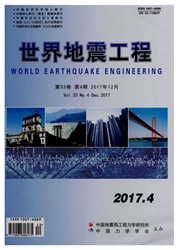

 中文摘要:
中文摘要:
依据不同阈值计算得到的70%能量持时的离散性大,造成了持时特性研究结果的不一致和持时的工程应用难以推广等影响。利用5·12汶川地震记录,对比分析5%~75%和15%~85%两种阈值对应的70%能量持时的差异,并探讨两者的空间变化规律,为确定70%能量持时提供设定合理阈值的依据。分析结果表明:15%~85%阈值对应的70%能量持时包含更多的非强震持时,而5%~75%阈值对应的70%能量持时对应地震动振动最强和最具破坏力的持时;两种阈值对应的70%能量持时均表现为随断层距的增加而增加;但5%~75%阈值定义的70%能量持时随断层距变化的拟合效果较15%~85%阈值的70%能量持时好。建议在确定70%能量持时前提下,取5%~75%作为阀值。
 英文摘要:
英文摘要:
The discreteness of 70% energy duration caused by different threshold values is large. It will lead to be inconsistent and difficult to apply in engineering. Records of Wenchuan earthquake were chosen to analysis the difference of 70% energy duration defined by the threshold values between from 5% to 75% and from 15% to 85%. The spatial variability law of 70% energy duration with fault distance was also discussed. The results indicate that the 70% energy duration defined by the threshold value from 15% to 85% often includes much larger time region which is not strong vibration,while the 70% energy duration defined by the threshold value from 5% to 75% represents the time region of the strongest and the most destructive vibration. 70% energy duration based on the two definitions of threshold values will increase with the fault distance increasing. By contrast,the 70% energy duration from 5% to 75% fitting fault distance is better than that from 15% to 85%. In view of Wenchuan earthquake records,suggested using total seismic energy between 5% and 75% as threshold to definition of 70% energy duration.
 同期刊论文项目
同期刊论文项目
 同项目期刊论文
同项目期刊论文
 期刊信息
期刊信息
